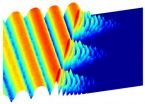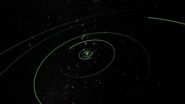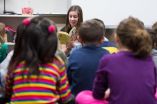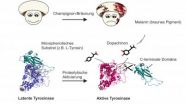(Press-News.org) Researchers at Princeton University have begun crystallizing light as part of an effort to answer fundamental questions about the physics of matter.
The researchers are not shining light through crystal – they are transforming light into crystal. As part of an effort to develop exotic materials such as room-temperature superconductors, the researchers have locked together photons, the basic element of light, so that they become fixed in place.
"It's something that we have never seen before," said Andrew Houck, an associate professor of electrical engineering and one of the researchers. "This is a new behavior for light."
The results raise intriguing possibilities for a variety of future materials. But the researchers also intend to use the method to address questions about the fundamental study of matter, a field called condensed matter physics.
"We are interested in exploring – and ultimately controlling and directing – the flow of energy at the atomic level," said Hakan Türeci, an assistant professor of electrical engineering and a member of the research team. "The goal is to better understand current materials and processes and to evaluate materials that we cannot yet create."
The team's findings, reported online on Sept. 8 in the journal Physical Review X, are part of an effort to answer fundamental questions about atomic behavior by creating a device that can simulate the behavior of subatomic particles. Such a tool could be an invaluable method for answering questions about atoms and molecules that are not answerable even with today's most advanced computers.
In part, that is because current computers operate under the rules of classical mechanics, which is a system that describes the everyday world containing things like bowling balls and planets. But the world of atoms and photons obeys the rules of quantum mechanics, which include a number of strange and very counterintuitive features. One of these odd properties is called "entanglement" in which multiple particles become linked and can affect each other over long distances.
The difference between the quantum and classical rules limits a standard computer's ability to efficiently study quantum systems. Because the computer operates under classical rules, it simply cannot grapple with many of the features of the quantum world. Scientists have long believed that a computer based on the rules of quantum mechanics could allow them to crack problems that are currently unsolvable. Such a computer could answer the questions about materials that the Princeton team is pursuing, but building a general-purpose quantum computer has proven to be incredibly difficult and requires further research.
Another approach, which the Princeton team is taking, is to build a system that directly simulates the desired quantum behavior. Although each machine is limited to a single task, it would allow researchers to answer important questions without having to solve some of the more difficult problems involved in creating a general-purpose quantum computer. In a way, it is like answering questions about airplane design by studying a model airplane in a wind tunnel – solving problems with a physical simulation rather than a digital computer.
In addition to answering questions about currently existing material, the device also could allow physicists to explore fundamental questions about the behavior of matter by mimicking materials that only exist in physicists' imaginations.
To build their machine, the researchers created a structure made of superconducting materials that contains 100 billion atoms engineered to act as a single "artificial atom." They placed the artificial atom close to a superconducting wire containing photons.
By the rules of quantum mechanics, the photons on the wire inherit some of the properties of the artificial atom – in a sense linking them. Normally photons do not interact with each other, but in this system the researchers are able to create new behavior in which the photons begin to interact in some ways like particles.
"We have used this blending together of the photons and the atom to artificially devise strong interactions among the photons," said Darius Sadri, a postdoctoral researcher and one of the authors. "These interactions then lead to completely new collective behavior for light – akin to the phases of matter, like liquids and crystals, studied in condensed matter physics."
Türeci said that scientists have explored the nature of light for centuries; discovering that sometimes light behaves like a wave and other times like a particle. In the lab at Princeton, the researchers have engineered a new behavior.
"Here we set up a situation where light effectively behaves like a particle in the sense that two photons can interact very strongly," he said. "In one mode of operation, light sloshes back and forth like a liquid; in the other, it freezes."
The current device is relatively small, with only two sites where an artificial atom is paired with a superconducting wire. But the researchers say that by expanding the device and the number of interactions, they can increase their ability to simulate more complex systems – growing from the simulation of a single molecule to that of an entire material. In the future, the team plans to build devices with hundreds of sites with which they hope to observe exotic phases of light such as superfluids and insulators.
"There is a lot of new physics that can be done even with these small systems," said James Raftery, a graduate student in electrical engineering and one of the authors. "But as we scale up, we will be able to tackle some really interesting questions."
INFORMATION:
Besides Houck, Türeci, Sadri and Raftery, the research team included Sebastian Schmidt, a senior researcher at the Institute for Theoretical Physics at ETH Zurich, Switzerland. Support for the project was provided by: the Eric and Wendy Schmidt Transformative Technology Fund; the National Science Foundation; the David and Lucile Packard Foundation; the U.S. Army Research Office; and the Swiss National Science Foundation.
'Solid' light could compute previously unsolvable problems
2014-09-09
ELSE PRESS RELEASES FROM THIS DATE:
An evolutionary approach to epidemics
2014-09-09
An evolutionary analysis of public health data during a major disease outbreak, such as bird flu, E. coli contamination of food or the current Ebola outbreak could help the emergency services plan their response and contain the disease more effectively. Details are reported in the International Journal of Innovative Computing and Applications.
Dehai Liu of the Dongbei University of Finance and Economics, in Dalian, Liaoning, China, and colleagues have used evolutionary game theory to examine the data associated with a major public health event - the emergence of a new ...
Squeezed quantum communication
2014-09-09
This news release is available in German. It could be difficult for the NSA to hack encrypted messages in the future – at least if a technology being investigated by scientists at the Max Planck Institute for the Science of Light in Erlangen and the University Erlangen-Nürnberg will be successful: quantum cryptography. The physicists are now laying the foundation to make this technique, which can already be used for the generation of secret keys, available for a wider range of applications. They are the first scientists to send a pulse of bright light in a particularly ...
First evidence for water ice clouds found outside solar system
2014-09-09
VIDEO:
A team of scientists led by Carnegie's Jacqueline Faherty has discovered the first evidence of water ice clouds on an object outside of our own Solar System. Water ice clouds...
Click here for more information.
Washington, D.C.—A team of scientists led by Carnegie's Jacqueline Faherty has discovered the first evidence of water ice clouds on an object outside of our own Solar System. Water ice clouds exist on our own gas giant planets--Jupiter, Saturn, Uranus, and Neptune--but ...
Fires continue in Northern California
2014-09-09
Storms have been the major cause of the huge fires that California has been battling in its northern regions.
A lightning strike from a storm on August 12, 2014 started the fires in the Happy Camp Complex. There are currently 99,200 acres affected and the fire complex is at 30% containment.
At around 4pm PDT on September 08, the smoke inversion lifted and fire behavior significantly increased on the south and southeast sides of the fire with spotting distances of up to a mile. Multiple spot fires occurred across the Scott River from Swanson Gulch and McGuffy Creek. ...
High-stakes testing, lack of voice driving teachers out
2014-09-09
EAST LANSING, Mich. --- Contrary to popular opinion, unruly students are not driving out teachers in droves from America's urban school districts. Instead, teachers are quitting due to frustration with standardized testing, declining pay and benefits and lack of voice in what they teach.
So finds a Michigan State University education scholar – and former high school teacher – in her latest research on teacher turnover, which costs the nation an estimated $2.2 billion a year.
Alyssa Hadley Dunn, assistant professor of teacher education, conducted in-depth interviews ...
RT and concurrent chemotherapy after surgery is effective treatment for high-risk endometrial cancer
2014-09-09
Fairfax, Va., September 9, 2014—Radiation therapy with concurrent paclitaxel chemotherapy following surgery is an effective treatment for patients with high-risk endometrial cancer, according to a study published in the September 1, 2014 edition of the International Journal of Radiation Oncology ● Biology ● Physics (Red Journal), the official scientific journal of the American Society for Radiation Oncology (ASTRO).
Endometrial cancer is the most common gynecologic malignancy. Patients with early-stage disease are typically treated with surgery alone; however, ...
PP&AR sets national agenda for long-term care
2014-09-09
The number of Americans needing long-term care — also called long-term services and supports (LTSS) — is projected to more than double to 27 million by 2050. Approximately 70 percent of people over the age of 65 will rely on some form of LTSS for an average of three years. The latest issue of Public Policy & Aging Report (PP&AR) lays down a policy prescription for a sustainable system of LTSS in the U.S., using the Federal Commission on Long-Term Care's 2013 final report as its foundation.
With support from The SCAN Foundation, the issue presents nine articles under ...
Why do mushrooms turn brown?
2014-09-09
This news release is available in German.
The research team of Annette Rompel from the Institute for Biophysical Chemistry, University of Vienna explore the mechanisms behind the "browning reaction" during the spoilage of mushrooms. The researchers were able to demonstrate that the enzyme responsible is already formed prior to fungal spoiling. The detailed study is published online in the well renowned journals, Phytochemistry and Acta Crystallographica.
Understanding the mechanism of enzyme tyrosinase pigmentation is currently of both medical as well as technological ...
Growth factors found in breast milk may protect against necrotizing enterocolitis
2014-09-09
Philadelphia, PA, September 9, 2014 – Necrotizing enterocolitis (NEC) is a devastating gastrointestinal illness affecting up to 10% of premature infants, with a 30% mortality rate, and formula feeding has been identified as a risk factor for NEC. A study published in The American Journal of Pathology found that growth factors present in human breast milk, but not in formula, may explain the protection against intestinal damage. Further, supplementing the diet of newborn NEC-affected rodents with these growth factors promotes epithelial cell survival.
"NEC is a highly ...
A weekly text message could encourage healthier food choices, new study shows
2014-09-09
Many people are unaware that the U.S. Food and Drug Administration's mandated nutrition labels are based on a 2,000-calorie-a-day diet, but a simple weekly text message reminder can greatly improve that awareness, according to a new study from the Johns Hopkins Bloomberg School of Public Health.
While not an outright recommendation, the 2,000-calorie benchmark is what the FDA considers a reasonable daily calorie intake for many adults. More importantly, nutrition labels on food products sold in the U.S. are based on it.
The key to translating nutrition labels and ...





